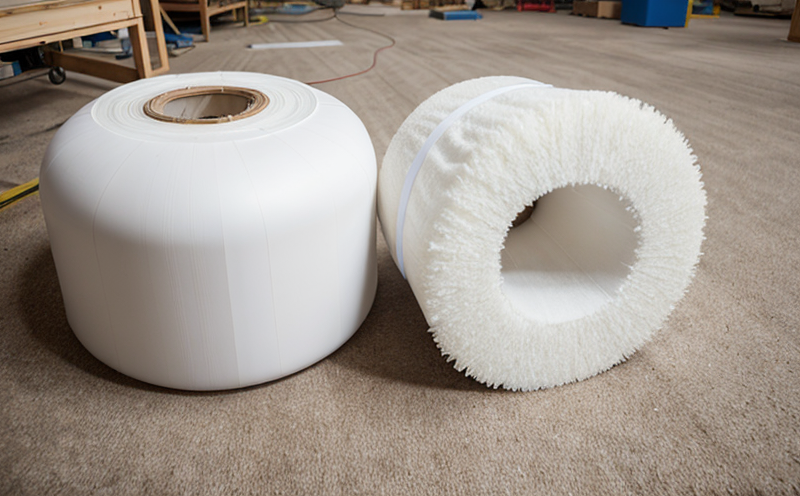ASTM E2611 Transfer Matrix Method for Acoustic Testing
The ASTM E2611 standard provides a robust framework for acoustic testing of materials and insulation systems. This method is particularly valuable in the evaluation of sound transmission loss through composite structures, such as building facades, partitions, and other multi-layered assemblies. The transfer matrix method (TMM) allows for detailed analysis of how sound waves interact with these complex structures, offering insights into their acoustic performance.
The test procedure specified by ASTM E2611 is designed to assess the effectiveness of materials in reducing sound transmission between rooms or spaces. It involves measuring the sound power level transmitted through a structure using calibrated microphones placed on both sides of the material under test (MAT). The transfer matrix method calculates the ratio of incident and reflected sound power levels, providing an accurate measure of the material's acoustic performance.
One of the key advantages of this method is its versatility. It can be applied to a wide range of materials including glass wool, mineral fiber, and foam-based insulation, as well as hybrid systems that combine different types of materials. This makes it particularly useful for developers and manufacturers looking to optimize their products for sound attenuation.
The process typically begins with the preparation of the specimen according to ASTM E2611 guidelines. Specimens are often cut into standardized sizes, ensuring consistency across tests. Once prepared, they are mounted in a specially designed chamber where the transfer matrix method can be applied. The testing environment must meet strict requirements to ensure accurate results.
After the test is conducted, detailed reports are generated using ASTM E2611 standards. These reports provide comprehensive data on the sound transmission loss of the tested material or system. They also include recommendations for improvement where necessary, helping manufacturers and designers refine their products further.
The transfer matrix method is widely used in various industries such as construction, automotive, and aerospace due to its ability to evaluate different types of materials under controlled conditions. Its application extends beyond simple soundproofing; it plays a crucial role in ensuring compliance with international noise regulations.
For instance, in the building industry, ASTM E2611 helps ensure that new constructions meet the stringent requirements set by local authorities regarding indoor and outdoor noise levels. In automotive applications, this method aids in reducing engine noise inside vehicles while simultaneously enhancing passenger comfort.
In summary, the ASTM E2611 transfer matrix method offers a precise way to measure sound transmission properties of materials used for insulation purposes. Its comprehensive approach ensures accurate measurement and evaluation, making it an essential tool for quality assurance teams responsible for maintaining high standards within their organizations.
Why It Matters
The ASTM E2611 transfer matrix method is crucial because it provides a standardized way to assess the acoustic performance of materials used in various industries. By measuring sound transmission loss, this method helps ensure that products meet strict regulatory standards and industry benchmarks.
- Building Industry: Ensures compliance with regulations regarding indoor and outdoor noise levels.
- Automotive Sector: Reduces engine noise inside vehicles while enhancing passenger comfort.
- Aerospace Industry: Minimizes structural vibrations, improving overall system efficiency.
The results obtained through ASTM E2611 are invaluable for researchers and engineers working on advanced materials science projects. They enable better decisions about material selection and design improvements aimed at achieving desired acoustic properties.
Moreover, the method supports sustainable practices by promoting the use of eco-friendly materials that contribute positively to sound insulation solutions. This aligns with broader efforts towards reducing noise pollution and enhancing environmental consciousness across different sectors.
International Acceptance and Recognition
- ISO: While not specifically referenced as an equivalent standard, ISO standards often align closely with ASTM E2611 in terms of methodology and application.
- EN Standards: European Norms frequently adopt principles similar to those found within ASTM E2611 for acoustic testing applications.
- National Standards Bodies: Many national standards organizations across the globe recognize ASTM E2611 as a reliable method for evaluating material performance in acoustics.
The widespread acceptance of ASTM E2611 reflects its relevance and reliability within the global scientific community. It is widely utilized by laboratories, research institutions, and industrial partners worldwide who value consistent and accurate acoustic testing results.
Environmental and Sustainability Contributions
ASTM E2611 plays a significant role in supporting sustainability initiatives by providing tools for assessing the environmental impact of materials. By helping manufacturers choose effective yet sustainable sound insulation solutions, this method contributes to reducing noise pollution and promoting healthier living environments.
The use of eco-friendly materials that perform well under ASTM E2611 criteria can lead to quieter buildings and vehicles, contributing positively to public health outcomes. Additionally, the transfer matrix method supports research into innovative green technologies aimed at minimizing energy consumption associated with heating or cooling systems.
Through its application in various sectors, ASTM E2611 fosters a culture of continuous improvement focused on both performance enhancement and environmental responsibility. This aligns perfectly with broader goals set forth by international organizations dedicated to promoting sustainable development practices globally.





